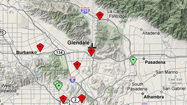Erica F. Solorzano
A 5th grade teacher at Latona Avenue Elementary in 2010
These graphs show a teacher's "value-added" rating based on his or her students' progress on the California Standards Tests in math and English. The Times’ analysis used all valid student scores available for this teacher from the 2003-04 through 2009-10 academic years. The value-added scores reflect a teacher's effectiveness at raising standardized test scores and, as such, capture only one aspect of a teacher's work.


Math effectiveness


English effectiveness
About this rating
The red lines show The Times’ value-added estimates for this teacher. Solorzano falls within the “less effective than average” category of district teachers in math and within the “least effective” category in English. These ratings were calculated based on test scores from 74 students.
Because this is a statistical measure, each score has a degree of uncertainty. The shading represents the range of values within which Solorzano’s actual effectiveness score is most likely to fall. The score is most likely to be in the center of the shaded area, near the red line, and less likely in the lightly shaded area. Teachers with ratings based on a small number of student test scores will a have wider shaded range.
The beige area shows how the district's 11,500 elementary school teachers are distributed across the categories.
Solorzano's LAUSD teaching history
Years used for value-added rating. See FAQ for details.
- Latona Avenue Elementary, 2010 - 2007
Erica Solorzano's Response:

What I don't understand is the rationale the Times is using to publish this information. They state,"Research has repeatedly found that teachers are the single most important school-related factor in a child's education." I'd like to read that so called research. Education is a partnership, between parents, students, teachers, administrators and the community, everyone counts in school-related factors. Schools need all stake holders involved in their students education.
I believe socio-economic status is a more likely predictor of test scores. Compare schools in economically disenfranchised communities vs schools in more affluent communities. Why not compare apples to apples; school to school in similar neighborhoods? It seems like the Times would like to actuate policy rather than uncover facts.
![]() The Times gave LAUSD elementary school teachers rated in this database the opportunity to preview their value-added evaluations and publicly respond. Some issues raised by teachers may be addressed in the FAQ. Teachers who have not commented may do so by contacting The Times.
The Times gave LAUSD elementary school teachers rated in this database the opportunity to preview their value-added evaluations and publicly respond. Some issues raised by teachers may be addressed in the FAQ. Teachers who have not commented may do so by contacting The Times.
|
|
 Delicious
Delicious
|
 Digg
Digg
|
 Facebook
Facebook
|
 Twitter
Twitter
|









